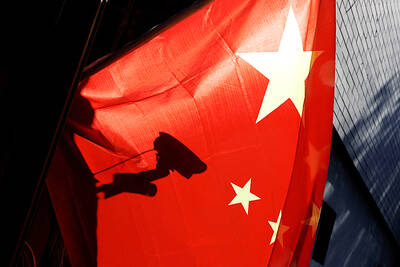Military experts from the US, Japan, and Taiwan yesterday stressed the necessity for the three countries to work together to maintain peace in the Taiwan Strait at a symposium hosted by the World Taiwanese Congress (WTC) in Taipei.
The WTC, an organization made up of overseas pro-independence Taiwanese from around the world, is currently holding its fifth annual conference in Taipei. The group plans to attend a rally today staged by the Hand-in-Hand Taiwan Alliance, to join the call for legislators to pass the long-stalled US arms procurement budget.
Kaneda Hideaki, who once served in Japan's maritime self-defense force, said at the symposium that China has been more aggressive in projecting its power abroad.
"China has been using its economic growth to expand its military capability," he said. "Starting with threatening Taiwan, China's ultimate goal is the whole world. The democratic countries in the Asia-Pacific region should therefore work together to counter China."
Vice Minister of the National Defense Ministry Michael Tsai (
"The modernization and expansion of China's military force has been beyond expectations," Tsai said. "Its annual military budget of US$30 billion is three times higher than that of Taiwan, not to mention the under-the-table budget, which is about three times [that amount]."
Tsai said that the ministry has been mulling the establishment of a military buffer zone between the two sides of the Strait, signing a code of military conduct with China and pursuing confidence-building mechanisms, all of which would require cooperation with the US and Japan.
Vice President Annette Lu (
"The illustration of China's military capability and its deployment in the US Pentagon report released in August indicated that Taiwan is facing an unprecedented crisis," Lu said.
The arms-procurement package was first brought up by the former ruling Chinese Nationalist Party (KMT), Lu said, noting that the reason why the KMT has changed its position on buying arms now is that it has lost the will to protect Taiwan after it lost power.
Gary Schmitt, the executive director of the Project for the New American Century, said that often in newly democratized countries it takes time for the new ruling party to learn how to govern and for the party losing power to learn how to appropriately monitor the government.
The stalemate over the arms-procurement budget package might therefore stem from Taiwanese parties' struggle to adjust to their new roles, Schmitt said. However, he noted that the parties should hurry their pace since Taiwan is facing a growing military threat from China.

A magnitude 7.0 earthquake struck off Yilan at 11:05pm yesterday, the Central Weather Administration (CWA) said. The epicenter was located at sea, about 32.3km east of Yilan County Hall, at a depth of 72.8km, CWA data showed There were no immediate reports of damage. The intensity of the quake, which gauges the actual effect of a seismic event, measured 4 in Yilan County area on Taiwan’s seven-tier intensity scale, the data showed. It measured 4 in other parts of eastern, northern and central Taiwan as well as Tainan, and 3 in Kaohsiung and Pingtung County, and 2 in Lienchiang and Penghu counties and 1

FOREIGN INTERFERENCE: Beijing would likely intensify public opinion warfare in next year’s local elections to prevent Lai from getting re-elected, the ‘Yomiuri Shimbun’ said Internal documents from a Chinese artificial intelligence (AI) company indicated that China has been using the technology to intervene in foreign elections, including propaganda targeting Taiwan’s local elections next year and presidential elections in 2028, a Japanese newspaper reported yesterday. The Institute of National Security of Vanderbilt University obtained nearly 400 pages of documents from GoLaxy, a company with ties to the Chinese government, and found evidence that it had apparently deployed sophisticated, AI-driven propaganda campaigns in Hong Kong and Taiwan to shape public opinion, the Yomiuri Shimbun reported. GoLaxy provides insights, situation analysis and public opinion-shaping technology by conducting network surveillance

Taiwan is gearing up to celebrate the New Year at events across the country, headlined by the annual countdown and Taipei 101 fireworks display at midnight. Many of the events are to be livesteamed online. See below for lineups and links: Taipei Taipei’s New Year’s Party 2026 is to begin at 7pm and run until 1am, with the theme “Sailing to the Future.” South Korean girl group KARA is headlining the concert at Taipei City Hall Plaza, with additional performances by Amber An (安心亞), Nick Chou (周湯豪), hip-hop trio Nine One One (玖壹壹), Bii (畢書盡), girl group Genblue (幻藍小熊) and more. The festivities are to

Auckland rang in 2026 with a downtown fireworks display launched from New Zealand’s tallest structure, Sky Tower, making it the first major city to greet the new year at a celebration dampened by rain, while crowds in Taipei braved the elements to watch Taipei 101’s display. South Pacific countries are the first to bid farewell to 2025. Clocks struck midnight in Auckland, with a population of 1.7 million, 18 hours before the famous ball was to drop in New York’s Times Square. The five-minute display involved 3,500 fireworks launched from the 240m Sky Tower. Smaller community events were canceled across New Zealand’s